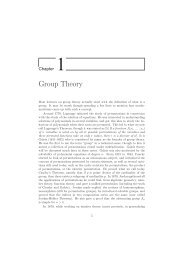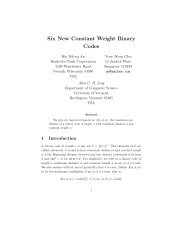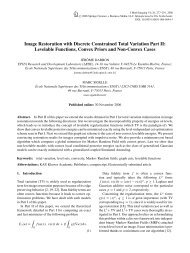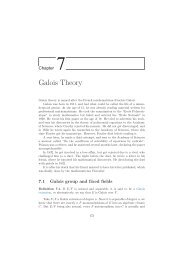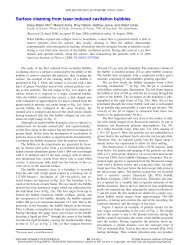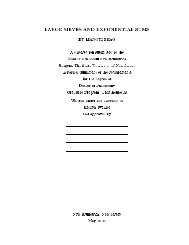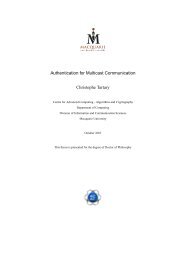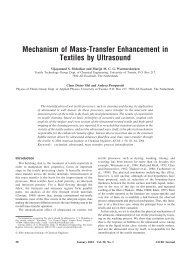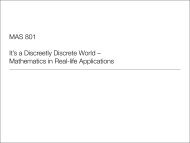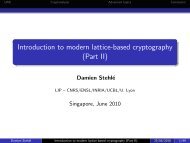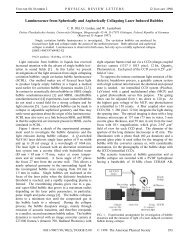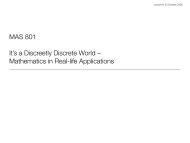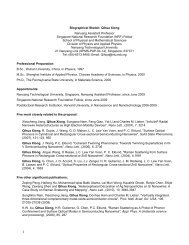Effect of Nuclei Concentration on Cavitation Cluster Dynamics M ...
Effect of Nuclei Concentration on Cavitation Cluster Dynamics M ...
Effect of Nuclei Concentration on Cavitation Cluster Dynamics M ...
You also want an ePaper? Increase the reach of your titles
YUMPU automatically turns print PDFs into web optimized ePapers that Google loves.
<str<strong>on</strong>g>Effect</str<strong>on</strong>g> <str<strong>on</strong>g>of</str<strong>on</strong>g> <str<strong>on</strong>g>Nuclei</str<strong>on</strong>g> <str<strong>on</strong>g>C<strong>on</strong>centrati<strong>on</strong></str<strong>on</strong>g> <strong>on</strong> Cavitati<strong>on</strong> <strong>Cluster</strong> <strong>Dynamics</strong>M. Arora, ∗ C.D. Ohl, and D. LohseDepartment <str<strong>on</strong>g>of</str<strong>on</strong>g> Applied Physics,Physics <str<strong>on</strong>g>of</str<strong>on</strong>g> Fluids,University <str<strong>on</strong>g>of</str<strong>on</strong>g> Twente,Postbus 217,7500 AE Enschede,The Netherlands.(Dated: July 2, 2007)1
AbstractCavitati<strong>on</strong> cluster dynamics after the passage <str<strong>on</strong>g>of</str<strong>on</strong>g> a single pressure waveis studied for different c<strong>on</strong>centrati<strong>on</strong>s <str<strong>on</strong>g>of</str<strong>on</strong>g> artificial cavitati<strong>on</strong> nuclei (30to 3 ·10 5 nuclei/ml). With increasing c<strong>on</strong>centrati<strong>on</strong> <str<strong>on</strong>g>of</str<strong>on</strong>g> cavitati<strong>on</strong> nucleithe life time <str<strong>on</strong>g>of</str<strong>on</strong>g> the cavitati<strong>on</strong> cluster is prol<strong>on</strong>ged. Additi<strong>on</strong>ally, wefind that the spatial extent <str<strong>on</strong>g>of</str<strong>on</strong>g> the cluster decreases with higher nucleic<strong>on</strong>centrati<strong>on</strong>. The experimental data for c<strong>on</strong>centrati<strong>on</strong>s less than 400nuclei/ml are compared to simulati<strong>on</strong>s with a Rayleigh-Plesset typeequati<strong>on</strong>, taking into account bubble-bubble interacti<strong>on</strong>. For higherc<strong>on</strong>centrati<strong>on</strong>s (more than 1000 nuclei/ml) the observed radial clusterdynamics is compared with an calculati<strong>on</strong>s from axisymmetric cavitycollapsemodel.2
The number density <str<strong>on</strong>g>of</str<strong>on</strong>g> bubbles is measured with a Neubauer cell-counting chamber under amicroscope. Even though the naturally present nuclei (e.g. dirt particles) may have largervariati<strong>on</strong>s in size (and thus corresp<strong>on</strong>ding nucleati<strong>on</strong> threshold), the usage <str<strong>on</strong>g>of</str<strong>on</strong>g> artificial nucleiallows us to have c<strong>on</strong>trol <strong>on</strong> number density independent <str<strong>on</strong>g>of</str<strong>on</strong>g> tensile strength used. Thedesired c<strong>on</strong>centrati<strong>on</strong>s <str<strong>on</strong>g>of</str<strong>on</strong>g> cavitati<strong>on</strong> nuclei are obtained by preparing successive itermediatediluti<strong>on</strong>s. Care is taken to ensure that the suspensi<strong>on</strong> is well mixed at each diluti<strong>on</strong> step.For all the experiments, partially degassed (approx. 3 mg/l O 2 c<strong>on</strong>tent, corresp<strong>on</strong>ding to30% <str<strong>on</strong>g>of</str<strong>on</strong>g> saturati<strong>on</strong> c<strong>on</strong>centrati<strong>on</strong>) and de-inoized water is used.The finally desired c<strong>on</strong>centrati<strong>on</strong> <str<strong>on</strong>g>of</str<strong>on</strong>g> artificial cavitati<strong>on</strong> nuclei is obtained by adding anappropriate amount <str<strong>on</strong>g>of</str<strong>on</strong>g> intermediate diluti<strong>on</strong> to a n<strong>on</strong>-seeded liquid in a bag around theacoustic focus <str<strong>on</strong>g>of</str<strong>on</strong>g> the shock wave generator. The bag is made from an acoustically andoptically transparent bag made <str<strong>on</strong>g>of</str<strong>on</strong>g> low density polyethylene. It c<strong>on</strong>tains approximately 10 l<str<strong>on</strong>g>of</str<strong>on</strong>g> liquid with the desired c<strong>on</strong>centrati<strong>on</strong> <str<strong>on</strong>g>of</str<strong>on</strong>g> cavitati<strong>on</strong> nuclei.Before the cavitati<strong>on</strong> nuclei are added the pressure signal at the acoustic focus <str<strong>on</strong>g>of</str<strong>on</strong>g> thelithotripter is recorded with a fiber optic hydroph<strong>on</strong>e (FOPH-500, RP Acoustics,Germany).Pressure measurements near to cavitati<strong>on</strong> bubble clusters are hampered because the fragilefiber tip is easily damaged especially at higher nuclei c<strong>on</strong>centrati<strong>on</strong>s.Figure ?? shows a typical pressure recording in the absence <str<strong>on</strong>g>of</str<strong>on</strong>g> artificial nuclei. Thepressure pulse c<strong>on</strong>sist <str<strong>on</strong>g>of</str<strong>on</strong>g> two phases: first a fast-rising compressive phase with a peak amplitude<str<strong>on</strong>g>of</str<strong>on</strong>g> 35 MPa lasting for 1.5µs. It is followed by a tensile phase with a peak amplitude<str<strong>on</strong>g>of</str<strong>on</strong>g> about -10 MPa lasting for approx. 3.5µs. This magnitude and durati<strong>on</strong> <str<strong>on</strong>g>of</str<strong>on</strong>g> the tensilephase is sufficient to cause cavitati<strong>on</strong> without artificial cavitati<strong>on</strong> nuclei, see top left frame<str<strong>on</strong>g>of</str<strong>on</strong>g> Fig. ??. The cavitati<strong>on</strong> bubbles around the focal regi<strong>on</strong> are well separated and they havea typical lifetime <str<strong>on</strong>g>of</str<strong>on</strong>g> 150 ± 10µs. The lifetime <str<strong>on</strong>g>of</str<strong>on</strong>g> a bubble is defined as the time periodbetween cavitati<strong>on</strong> incepti<strong>on</strong> and the first collapse <str<strong>on</strong>g>of</str<strong>on</strong>g> the bubble. In the absence <str<strong>on</strong>g>of</str<strong>on</strong>g> artificialcavitati<strong>on</strong> nuclei about 20 cavitati<strong>on</strong> bubbles per ml are expanded in the focal regi<strong>on</strong>.After adding artificial cavitati<strong>on</strong> nuclei the shape <str<strong>on</strong>g>of</str<strong>on</strong>g> the sec<strong>on</strong>d part <str<strong>on</strong>g>of</str<strong>on</strong>g> the pressurewave gets str<strong>on</strong>gly modified, whereas the first part remains practically the same (see inset4
Fig. ??). These effects are enhanced with increased c<strong>on</strong>centrati<strong>on</strong> <str<strong>on</strong>g>of</str<strong>on</strong>g> cavitati<strong>on</strong> bubbles. Asimilar finding has been reported recently by Liebleret al. 15 .The dynamics <str<strong>on</strong>g>of</str<strong>on</strong>g> the cavitati<strong>on</strong> cluster is recorded with a high speed CMOS-camera(ultima APX-RS Fastcam, Photr<strong>on</strong>) at a framing rate <str<strong>on</strong>g>of</str<strong>on</strong>g> 50000 fps. The size <str<strong>on</strong>g>of</str<strong>on</strong>g> the imagesis 384 pixel × 112 pixel which corresp<strong>on</strong>d to a field <str<strong>on</strong>g>of</str<strong>on</strong>g> view <str<strong>on</strong>g>of</str<strong>on</strong>g> 79 mm × 23 mm. This givesan optical resoluti<strong>on</strong> <str<strong>on</strong>g>of</str<strong>on</strong>g> 206µm per pixel. Thus isolated bubbles with a radius <str<strong>on</strong>g>of</str<strong>on</strong>g> approx.200µm can be resolved. The high-speed camera is triggered simultaneously with the shockwave generator and the scene is illuminated with diffuse back-illuminati<strong>on</strong>. The life-time <str<strong>on</strong>g>of</str<strong>on</strong>g>the cavitati<strong>on</strong> clusters is determined by visual inspecti<strong>on</strong> <str<strong>on</strong>g>of</str<strong>on</strong>g> the recordings. Additi<strong>on</strong>ally, thewidth <str<strong>on</strong>g>of</str<strong>on</strong>g> sufficiently dense cavitati<strong>on</strong> clusters are determined by digital image processing.Figure ?? depicts the shape <str<strong>on</strong>g>of</str<strong>on</strong>g> the cavitati<strong>on</strong> cluster at various c<strong>on</strong>centrati<strong>on</strong>s <str<strong>on</strong>g>of</str<strong>on</strong>g> cavitati<strong>on</strong>nuclei 65µs, 165µs and 265µs after the shock-fr<strong>on</strong>t has passed the acoustic focus.At low to moderate c<strong>on</strong>centrati<strong>on</strong>s <str<strong>on</strong>g>of</str<strong>on</strong>g> the cavitati<strong>on</strong> nuclei (37 to 370 nuclei/ml) individualbubbles larger than the optical resoluti<strong>on</strong> <str<strong>on</strong>g>of</str<strong>on</strong>g> the system can be identified. Bey<strong>on</strong>d 1000nuclei/ml it becomes increasingly difficult to separate individual bubbles from each other.Interestingly, the life-time <str<strong>on</strong>g>of</str<strong>on</strong>g> the cavitati<strong>on</strong> cluster increases from 150µs for the plainwater case to 350µs for the highest c<strong>on</strong>centrati<strong>on</strong>, see Fig. ??. In an attempt to model thecavitati<strong>on</strong> cluster dynamics we distinguish between the case <str<strong>on</strong>g>of</str<strong>on</strong>g> sparsely populated bubbleclusters, defined as a cluster <str<strong>on</strong>g>of</str<strong>on</strong>g> bubbles that do not grow to come close to each other, andthe case <str<strong>on</strong>g>of</str<strong>on</strong>g> densly populated bubble cluster, in which the bubbles do come fairly close duringthe growth. For the first case (nuclei c<strong>on</strong>centrati<strong>on</strong>s below 400 nuclei/ml) a modified sphericalRayleigh-Plesset equati<strong>on</strong> is applied at the level <str<strong>on</strong>g>of</str<strong>on</strong>g> the individual bubble (secti<strong>on</strong> III),whereas in the sec<strong>on</strong>d case an axisymmetric model for the volume dynamics <str<strong>on</strong>g>of</str<strong>on</strong>g> the densecluster is employed (secti<strong>on</strong> IV).5
III. DYNAMICS OF SPARSELY POPULATED CLUSTERSThe Rayleigh-Plesset (RP) model describes the dynamics <str<strong>on</strong>g>of</str<strong>on</strong>g> single spherical bubbles.It is derived by integrating the momentum balance equati<strong>on</strong> in radial directi<strong>on</strong> assumingspherical symmetry 19,20 .(R ¨R + 2Ṙ2 3 = 1 P g + P v − P(t) − P 0 − 2σ ρR − 4ηṘR − R P ˙ )gc l(1)Here, R is the radius <str<strong>on</strong>g>of</str<strong>on</strong>g> the single cavity, P 0 = 1.013 · 10 5 Pa is the c<strong>on</strong>stant atmosphericpressure, P(t) is the far-field driving sound pressure (shown in Fig. ??) and P g the pressureinside the cavitati<strong>on</strong> bubble, calculated assuming adiabatic gas law:P g =(P 0 + 2σ ) ( ) 3γ R0− P v . (2)R 0 RThe remaining physical parameters are density ρ = 1000kg·m −3 , coefficient <str<strong>on</strong>g>of</str<strong>on</strong>g> surface tensi<strong>on</strong>σ = 0.073kg·s −2 , water viscosity η = 1.00 × 10 −3 Pa·s and sound velocity in water c l =1485m/s. The last three terms in the brackets <str<strong>on</strong>g>of</str<strong>on</strong>g> Eq. 1 refer to the affect <str<strong>on</strong>g>of</str<strong>on</strong>g> surface tensi<strong>on</strong>,viscosity and sound emissi<strong>on</strong> from the bubble. Although we include these terms in thepresent analysis for completeness, they hardly effect the dynamics <str<strong>on</strong>g>of</str<strong>on</strong>g> the bubble. In aminimalistic model these terms also can be neglected. So far the model does not include theeffect <str<strong>on</strong>g>of</str<strong>on</strong>g> neighboring bubbles.To modify this equati<strong>on</strong> to include bubble-bubble interacti<strong>on</strong> an additi<strong>on</strong>al pressure termneeds to be added. It can be derived from the summed velocity potential <str<strong>on</strong>g>of</str<strong>on</strong>g> neighboringbubbles 10,21 :φ =( ∑i)1R˙i Ri2 r i, (3)where r i is the distance to its i th neighbor bubble with radii R i . The higher order interacti<strong>on</strong>terms, as <str<strong>on</strong>g>of</str<strong>on</strong>g>ten derived in the case <str<strong>on</strong>g>of</str<strong>on</strong>g> two bubbles 22 , can also be computed for multibubblesystems 9 and but are are neglected in this analysis. Further, we assume that locally allbubbles show the same radial dynamics, thus subscript i can be dropped from R i . With the6
assumpti<strong>on</strong> <str<strong>on</strong>g>of</str<strong>on</strong>g> a uniform number density <str<strong>on</strong>g>of</str<strong>on</strong>g> cavitati<strong>on</strong> nuclei per unit volume, N, Eq. (3)can be rewritten as an integral in space:φ = R 2 Ṙ ∑ i∫1δr≈ R 2 1ṘN dr ′ . (4)r i 0 r ′4πr′2Here, δr is the distance up to which bubble-bubble interacti<strong>on</strong>s are c<strong>on</strong>sidered. We notethat the integral, Eq. (4), grows unbounded for δr → ∞. In reality the finite speed <str<strong>on</strong>g>of</str<strong>on</strong>g> soundand the acoustic shielding by bubbles prevent their mutual interacti<strong>on</strong> at larger distances.Thus δr should be restricted to a finite distance. Here, we choose as a first approximati<strong>on</strong>a c<strong>on</strong>centrati<strong>on</strong> dependent cut-<str<strong>on</strong>g>of</str<strong>on</strong>g>f distance <str<strong>on</strong>g>of</str<strong>on</strong>g> <strong>on</strong>e average inter-bubble distance D mean :δr ≡ D mean = 1N1/3. (5)After adding the time derivative <str<strong>on</strong>g>of</str<strong>on</strong>g> Eq. (4) as an additi<strong>on</strong>al pressure term into the RPEq. (1) we obtain(αR ¨R + βṘ2 = 1 P b − P(t) − P 0 − 2σ ρR − 4ηṘR − R P ˙ )gc l, (6)where α = ( 1 + 2πRN 1/3) and β = ( 32 + 4πRN1/3) .Please, note that when N → 0, the original RP equati<strong>on</strong> is obtained. With modifiedRP Eq. (6) we calculate the change in the radial dynamics <str<strong>on</strong>g>of</str<strong>on</strong>g> the bubbles and their collapsetime for various nuclei c<strong>on</strong>centrati<strong>on</strong>s. Figure ?? compares the radial dynamics <str<strong>on</strong>g>of</str<strong>on</strong>g> a singlebubble with an initial size <str<strong>on</strong>g>of</str<strong>on</strong>g> 1µm being driven by a single pressure pulse for N= 0, 1 and 100nuclei/ml. The driving pressure pulse used in all the above cases is the measured pressurepulse (with no artificial nuclei) as shown in fig. ??. The graph shows that the bubble lifetime is increased and its maximum size is reduced at increasing densities <str<strong>on</strong>g>of</str<strong>on</strong>g> cavitati<strong>on</strong> nuclei.In fig. ?? the collapse time as a functi<strong>on</strong> <str<strong>on</strong>g>of</str<strong>on</strong>g> nucleus c<strong>on</strong>centrati<strong>on</strong> is plotted as a dashed lineand it is compared with experimental measurements(vertical error bars).In agreement with the observati<strong>on</strong>, the model predicts an increase in the bubble life time<str<strong>on</strong>g>of</str<strong>on</strong>g> 50µs when the c<strong>on</strong>centrati<strong>on</strong> is increased from 40 nuclei/ml to ≈ 400 nuclei/ml. Although7
the predicti<strong>on</strong>s are within the measured error limits, it should be noted that the recordedpressure pulse used for the driving far-feild pressure, P(t), in Eq. (6) is already affectedby the presence <str<strong>on</strong>g>of</str<strong>on</strong>g> nearby bubbles. Therefore, the agreement <str<strong>on</strong>g>of</str<strong>on</strong>g> the absolute collapse timeshould be taken with some cauti<strong>on</strong>. It has been found that the peaks following the tensilephase as depicted in Fig. ?? do alter the absolute collapse time.At higher c<strong>on</strong>centrati<strong>on</strong>s the bubbles very close to each other and the model becomesinapplicable. Therefore, in order to capture the cloud dynamics at higher number densitieswe make use <str<strong>on</strong>g>of</str<strong>on</strong>g> a different model which describes the cluster as a single cylindrical void.IV. DYNAMICS OF DENSELY POPULATED CLUSTERSFor number densities above 1000 bubbles/ml the cluster looks quite different, see Fig. ??:The shape <str<strong>on</strong>g>of</str<strong>on</strong>g> the cluster becomes more homogeneous and it is separated from the surroundingliquid by a sharp boundary. The collapse <str<strong>on</strong>g>of</str<strong>on</strong>g> the cluster proceeds progressively from thecluster boundary toward its center. These observati<strong>on</strong>s suggest to model the shrinkage <str<strong>on</strong>g>of</str<strong>on</strong>g>the cluster boundary as a shock fr<strong>on</strong>t. The speed, Ẋ, at which the cluster collapses isidentified with the propagati<strong>on</strong> speed <str<strong>on</strong>g>of</str<strong>on</strong>g> the shock fr<strong>on</strong>t 23,24 which is given by:( ) 1/2P 1Ẋ =. (7)ρβ(1 − β)Here, P 1 is the pressure just outside the cavitati<strong>on</strong> cluster driving the collapse, and β thevoid fracti<strong>on</strong> within the cluster. In the case <str<strong>on</strong>g>of</str<strong>on</strong>g> a cavitati<strong>on</strong> cluster with well separatedspherical bubbles β is given by N · 43 πR3 , which in general is a time varying quantity.However, when the bubbles grow those inside the cluster become increasingly shielded fromthe outside pressure field and for large N, and we can assume that inside the cluster β reachesa c<strong>on</strong>stant value. Note that, for large enough void fracti<strong>on</strong>s, β > 0.1, the time required tocollapse individual bubbles is <str<strong>on</strong>g>of</str<strong>on</strong>g> the same order <str<strong>on</strong>g>of</str<strong>on</strong>g> magnitude as that for the passage <str<strong>on</strong>g>of</str<strong>on</strong>g> shockfr<strong>on</strong>t over the bubble ∼ R√ρP 1, further justifying identificati<strong>on</strong> <str<strong>on</strong>g>of</str<strong>on</strong>g> the speed <str<strong>on</strong>g>of</str<strong>on</strong>g> the clustercollapse with the speed <str<strong>on</strong>g>of</str<strong>on</strong>g> the shock fr<strong>on</strong>t.The pressure P 1 just outside the cylindrical cluster is coupled with the far field pressure8
P 0 far away by a momentum balance in cylindrical coordinates. As derived by Hanss<strong>on</strong> andMørch 23 , the moti<strong>on</strong> <str<strong>on</strong>g>of</str<strong>on</strong>g> the cluster boundary X can be modelled with a sec<strong>on</strong>d order ODE:(XẌ + Ẋ2 )ln x cX − Ẋ2 + β 2Ẋ2 [ (Xx c) 2+ 1]= − 1ρβ P 0 . (8)Here x c is the typical size scale <str<strong>on</strong>g>of</str<strong>on</strong>g> the experimental setup, in our case x c = 0.2 m, is approximatelythe radius <str<strong>on</strong>g>of</str<strong>on</strong>g> the liquid compartment. For the limiting case <str<strong>on</strong>g>of</str<strong>on</strong>g> β = 1, the aboveequati<strong>on</strong> becomes the the void collapse equati<strong>on</strong> in cylindrical geometry 25,26 (2D-Rayleighequati<strong>on</strong>).Figure ?? compares the experimentally measured diameter <str<strong>on</strong>g>of</str<strong>on</strong>g> the cavitati<strong>on</strong> cluster withEq. (8) for a cavitati<strong>on</strong> nuclei density <str<strong>on</strong>g>of</str<strong>on</strong>g> a) 3 · 10 5 bubbles/ml and b) 3.7 · 10 3 bubbles/ml.As there is no simple experimental means for measuring the void fracti<strong>on</strong> β, the modelcalculati<strong>on</strong>s have been fitted to the experimental collapse time by choosing β = 0.34 and0.22 respectively. Thus, we find that increase <str<strong>on</strong>g>of</str<strong>on</strong>g> the number <str<strong>on</strong>g>of</str<strong>on</strong>g> cavitati<strong>on</strong> nuclei leads toan increase <str<strong>on</strong>g>of</str<strong>on</strong>g> the maximum value <str<strong>on</strong>g>of</str<strong>on</strong>g> β, but shielding limits the growth <str<strong>on</strong>g>of</str<strong>on</strong>g> the bubbles, andthus the effect <str<strong>on</strong>g>of</str<strong>on</strong>g> increasing N.It is interesting to note, that the maximum bubble radius can be estimated from thebest fit value <str<strong>on</strong>g>of</str<strong>on</strong>g> the void fracti<strong>on</strong>. We find for β = 0.34 and β = 0.22 with the respectivenumber densities a bubble radius R <str<strong>on</strong>g>of</str<strong>on</strong>g> 0.06 mm and 0.24 mm, respectively. Although, theoptical resoluti<strong>on</strong> <str<strong>on</strong>g>of</str<strong>on</strong>g> 0.2 mm/pixel does not allow a direct measurement <str<strong>on</strong>g>of</str<strong>on</strong>g> the bubble radius,individual bubbles can be identified in Fig. ??b, whereas it can not be d<strong>on</strong>e for the β = 0.34case, see Fig. ??a.V. CONCLUSIONThe dynamics <str<strong>on</strong>g>of</str<strong>on</strong>g> cavitati<strong>on</strong> clusters is str<strong>on</strong>gly modified when artificial cavitati<strong>on</strong> nucleiare added. With increasing c<strong>on</strong>centrati<strong>on</strong> <str<strong>on</strong>g>of</str<strong>on</strong>g> nuclei we find a prol<strong>on</strong>gati<strong>on</strong> <str<strong>on</strong>g>of</str<strong>on</strong>g> the lifetime anda decrease in the maximum bubble size. Two regimes <str<strong>on</strong>g>of</str<strong>on</strong>g> cluster dynamics are c<strong>on</strong>sidered:With nuclei number densities below 400 bubbles/ml sparsely populated clusters with fuzzy9
oundaries are developed. For these, the presented modified RP equati<strong>on</strong> including nearestneighbor interacti<strong>on</strong> terms seems to give a sufficient descripti<strong>on</strong> <str<strong>on</strong>g>of</str<strong>on</strong>g> the bubble dynamics atthe center <str<strong>on</strong>g>of</str<strong>on</strong>g> the cluster. Tanguay and Col<strong>on</strong>ius 11 in their numerical simulati<strong>on</strong>s also findincrease in lifetime <str<strong>on</strong>g>of</str<strong>on</strong>g> bubbles but also an increase in the maximum size <str<strong>on</strong>g>of</str<strong>on</strong>g> the bubbles withincreasing void fracti<strong>on</strong>. Even though the model for the sparse cluster presented in this workagrees with the experimental results it is subject to further verificati<strong>on</strong>. Of interest might beexperiments which record the bubble size and the void fracti<strong>on</strong> independently as functi<strong>on</strong> <str<strong>on</strong>g>of</str<strong>on</strong>g>time. In the sec<strong>on</strong>d regime, i.e. for bubble densities <str<strong>on</strong>g>of</str<strong>on</strong>g> 1000 nuclei/ml and above it becomesmore appropriate to model the cluster as a single entity having a c<strong>on</strong>stant void fracti<strong>on</strong>.Here, very high void fracti<strong>on</strong>s in the range <str<strong>on</strong>g>of</str<strong>on</strong>g> 20-35% agree with collapse dynamics. Yet, toincrease c<strong>on</strong>fidence into these models further experiments with other pressure sources shouldbe c<strong>on</strong>ducted to evaluate the robustness <str<strong>on</strong>g>of</str<strong>on</strong>g> the rather simple models.The range <str<strong>on</strong>g>of</str<strong>on</strong>g> cavitati<strong>on</strong> nucleus densities examined in this study extends much bey<strong>on</strong>dthe range in which single bubble models are applicable. Real life nucleati<strong>on</strong> c<strong>on</strong>diti<strong>on</strong>sare likely to generate sparsely populated as well as densely populated bubble clusters. Forexample, in lithotripsy sparsely populated clusters may arise form natural nuclei presentin-vivo or in-vitro, while densely populated clusters require accumulati<strong>on</strong> <str<strong>on</strong>g>of</str<strong>on</strong>g> extra nuclei.Such extra nuclei may come from fragmentati<strong>on</strong> <str<strong>on</strong>g>of</str<strong>on</strong>g> st<strong>on</strong>e pieces, or may be gaseous remains<str<strong>on</strong>g>of</str<strong>on</strong>g> cavitati<strong>on</strong> bubbles from previous shots 12 . Similarly, cavity clusters are likely to be createdin high intensity ultras<strong>on</strong>ic equipment such as ultras<strong>on</strong>ic cleaners, s<strong>on</strong>o-chemical reactors,etc., depending <strong>on</strong>ly <strong>on</strong> the number <str<strong>on</strong>g>of</str<strong>on</strong>g> cavitati<strong>on</strong> nuclei being present in the active regi<strong>on</strong><str<strong>on</strong>g>of</str<strong>on</strong>g> the device.The absolute values <str<strong>on</strong>g>of</str<strong>on</strong>g> the nucleus densities characteristic <str<strong>on</strong>g>of</str<strong>on</strong>g> the two regimes definedin this paper will vary in dependence <str<strong>on</strong>g>of</str<strong>on</strong>g> the parameters <str<strong>on</strong>g>of</str<strong>on</strong>g> tensile phase, such as its pulsestrength and durati<strong>on</strong>, properties <str<strong>on</strong>g>of</str<strong>on</strong>g> the liquid in which cavitati<strong>on</strong> is taking place, etc..The funding <str<strong>on</strong>g>of</str<strong>on</strong>g> the work by FOM and NWO (both The Netherlands) is acknowledged.We are very thankful to Knud Aage Mørch and Andrea Prosperetti for various insightfuldiscussi<strong>on</strong>s and refining the manuscript. We are also greatful to Marko Liebler (University10
<str<strong>on</strong>g>of</str<strong>on</strong>g> Karlsruhe) for illuminating us <strong>on</strong> wave propagati<strong>on</strong> at higher nuclei densities.References1 G.E. Reisman, Y.C. Wang, and C.E. Brennen, “Observati<strong>on</strong>s <str<strong>on</strong>g>of</str<strong>on</strong>g> shock waves in cloudcavitati<strong>on</strong>,” J. Fluid Mech. 355, 255-283 (1998).2 G. Kuiper, “Cavitati<strong>on</strong> research and ship propeller design”, Applied Scientific Research,58,33-50 (1998).3 C.E. Brennen,Cavitati<strong>on</strong> and Bubble <strong>Dynamics</strong> (Oxford Univ. Press, 1995).4 O.A. Sapozhnikov, V.A. Khokhlova, M.R. Bailey, and L.A. Crum, “<str<strong>on</strong>g>Effect</str<strong>on</strong>g> <str<strong>on</strong>g>of</str<strong>on</strong>g> overpressureand pulse repetiti<strong>on</strong> frequency <strong>on</strong> cavitati<strong>on</strong> in shock wave lithotripsy,” J. Acoust. Soc.Am. 112, 1183-1195 (2002).5 Y. Matsumoto, J.S. Allen, S. Yoshizawa, T. Ikeda, and Y. Kaneko, “Medical ultrasoundwith microbubbles,” Exp. Therm. Fluid Sci. 29, 225-265 (2005).6 L. van Wijngaarden, “On equati<strong>on</strong>s <str<strong>on</strong>g>of</str<strong>on</strong>g> moti<strong>on</strong> for mixtures <str<strong>on</strong>g>of</str<strong>on</strong>g> liquid and gas bubbles,” J.Fluid Mech. 33, 465-474 (1968).7 D.Z. Zhang and A. Prosperetti, “Averaged equati<strong>on</strong>s for inviscid disperse two-phase flow,”J. Fluid Mech. 267,185219 (1994).8 Y.C. Wang and C.E. Brennen, “Numerical computati<strong>on</strong> <str<strong>on</strong>g>of</str<strong>on</strong>g> shock waves in a sphericalcloud <str<strong>on</strong>g>of</str<strong>on</strong>g> cavitati<strong>on</strong> bubbles,” J. Fluids Eng. Trans. ASME 121, 872-880 (1999).9 G.L. Chahine, “Pressure generated by a bubble cloud collapse,” Chem. Eng. Commun.28, 355-367 (1983).10 G.L. Chahine, and H. L. Liu , “A Singular Perturbati<strong>on</strong> Theory <str<strong>on</strong>g>of</str<strong>on</strong>g> the Growth <str<strong>on</strong>g>of</str<strong>on</strong>g> aBubble <strong>Cluster</strong> in a Superheated Liquid”, J. Fluid Mech., 156, 257-279, 1985.11 M. Tanguay and T. Col<strong>on</strong>ius, “Progress in Modeling and Simulati<strong>on</strong> <str<strong>on</strong>g>of</str<strong>on</strong>g> ShockwaveLithotripsy (SWL),” in Fifth Internati<strong>on</strong>al Symposium <strong>on</strong> Cavitati<strong>on</strong> (CAV2003), 1-4November 2003, Osaka, Japan.12 M. Arora, L. Junge, and C.D. Ohl, “Cavitati<strong>on</strong> cluster dynamics in shock-wave11
lithotripsy: Part 1. Free field,” Ultrasound Med. Biol., 31, 827-839 (2005).13 N. Brem<strong>on</strong>d, M. Arora, S. Dammer, C.D. Ohl, and D. Lohse, “Bubble nucleati<strong>on</strong> <strong>on</strong>surfaces”, J. Phys.: C<strong>on</strong>dens. Matter, 17 S3603-S3608 (2005).14 Y. C. Wang, “<str<strong>on</strong>g>Effect</str<strong>on</strong>g>s <str<strong>on</strong>g>of</str<strong>on</strong>g> nuclei size distributi<strong>on</strong> <strong>on</strong> the dynamics <str<strong>on</strong>g>of</str<strong>on</strong>g> a spherical cloud <str<strong>on</strong>g>of</str<strong>on</strong>g>cavitati<strong>on</strong> bubbles”, J. Fluids Eng. Trans. ASME 121, 881-886 (1999)15 M. Liebler, T. Dreyer, R.E. Riedlinger, “N<strong>on</strong>linear Modelling <str<strong>on</strong>g>of</str<strong>on</strong>g> Interacti<strong>on</strong>s betweenUltrasound and Cavitati<strong>on</strong> Bubbles”,Acta Acustica, 2006(in press).16 K.S. Suslick,“S<strong>on</strong>ochemistry”,Science,247,1439-1445 (1990).17 P.M. Kanthale, P.R. Gogate, A.B. Pandit, and A.M. Wilhelm,“<strong>Dynamics</strong> <str<strong>on</strong>g>of</str<strong>on</strong>g> cavitati<strong>on</strong>albubbles and design <str<strong>on</strong>g>of</str<strong>on</strong>g> a hydrodynamic cavitati<strong>on</strong>al reactor: cluster approach”,Ultras<strong>on</strong>icsS<strong>on</strong>ochemistry, 12,441-452 (2005).18 R. Riedlinger,T. Dreyer, and W. Krauss, “Small aperture piezo sources for lithotripsy,”In Proc. 17th Int. C<strong>on</strong>gress <strong>on</strong> Acoustics. vol 4 ed A Bettucci, 2001, Rome, Italy.19 Rayleigh, Lord. “On the pressure developed in a liquid during the collapse <str<strong>on</strong>g>of</str<strong>on</strong>g> a sphericalcavity”, Phil. Mag., 34, 94-98 (1917).20 M.S. Plesset, and A. Prosperetti, “Bubble dynamics and cavitati<strong>on</strong>”, Ann. Rev. FluidMech., 9, 145-185 (1977).21 A. Kubota, H. Kota, H. Yamaguchi,“A New Modeling <str<strong>on</strong>g>of</str<strong>on</strong>g> Cavitating Flows - A NumericalStudy <str<strong>on</strong>g>of</str<strong>on</strong>g> Unsteady Cavitati<strong>on</strong> <strong>on</strong> a Hydr<str<strong>on</strong>g>of</str<strong>on</strong>g>oil secti<strong>on</strong>”, J. Fluid Mech.,240, 59-96 (2002).22 A. Harkin, T.J. Kaper, A. Nadim,“Coupled pulsati<strong>on</strong> and translati<strong>on</strong> <str<strong>on</strong>g>of</str<strong>on</strong>g> two gas bubblesin a liquid”,J. Fluid Mech.,445, 377-411 (2001).23 I. Hanss<strong>on</strong> and K.A. Mørch, “The <strong>Dynamics</strong> <str<strong>on</strong>g>of</str<strong>on</strong>g> Cavity <strong>Cluster</strong>s in Ultras<strong>on</strong>ic (Vibratory)Cavitati<strong>on</strong> Erosi<strong>on</strong>”, J. Appl. Phy., 51, 4651-4658 (1980).24 K.A. Mørch, “On Cavity <strong>Cluster</strong> Formati<strong>on</strong> in a Focused Acoustic Field”, J. Fluid Mech.,201, 57-76 (1989).25 H. N. Oguz and A. Prosperetti,“<strong>Dynamics</strong> <str<strong>on</strong>g>of</str<strong>on</strong>g> Bubble-Growth and detachment from aneedle”, J. Fluid Mech., 257, 111-145 (1993).26 D. Lohse, R. Bergmann, R. Mikkelsen, C. Zeilstra, D. van der Meer, M. Versluis, K. van12
der Weele, M. van der Hoef, and H. Kuipers, “Impact <strong>on</strong> s<str<strong>on</strong>g>of</str<strong>on</strong>g>t sand: Void collapse and jetformati<strong>on</strong>”, Phys. Rev. Lett., 93, 198003 (2004).13
List <str<strong>on</strong>g>of</str<strong>on</strong>g> FiguresFIG. 1A typical pressure recording at the focus <str<strong>on</strong>g>of</str<strong>on</strong>g> the lithotripter in the absence <str<strong>on</strong>g>of</str<strong>on</strong>g>artificial cavitati<strong>on</strong> nuclei. The inset dem<strong>on</strong>strates the effect <str<strong>on</strong>g>of</str<strong>on</strong>g> additi<strong>on</strong> <str<strong>on</strong>g>of</str<strong>on</strong>g>cavitati<strong>on</strong> nuclei <strong>on</strong> the pressure wave at the focus. With increasing numbers<str<strong>on</strong>g>of</str<strong>on</strong>g> cavitati<strong>on</strong> nuclei (indicated by directi<strong>on</strong> the <str<strong>on</strong>g>of</str<strong>on</strong>g> the arrow) the durati<strong>on</strong> <str<strong>on</strong>g>of</str<strong>on</strong>g>the tensile phase decreases and a sec<strong>on</strong>dary positive pressure pulse emerges.The primary pressure peak remains almost unaffected. . . . . . . . . . . . . 15FIG. 2Cavitati<strong>on</strong> bubble clusters at three different times after the passage <str<strong>on</strong>g>of</str<strong>on</strong>g> theshock wave as obtained with various initial cavitati<strong>on</strong> nuclei c<strong>on</strong>centrati<strong>on</strong>,as stated at each row. The top row (c<strong>on</strong>trol) corresp<strong>on</strong>ds to the case <str<strong>on</strong>g>of</str<strong>on</strong>g> plainwater. The size <str<strong>on</strong>g>of</str<strong>on</strong>g> each frame is 79 mm × 23 mm. . . . . . . . . . . . . . . 16FIG. 3Radius-Time curve for individual bubbles at different nucleus c<strong>on</strong>centrati<strong>on</strong>swhen driven the pressure pulse in fig. reffig:pressure. The solid line corresp<strong>on</strong>dsto the case <str<strong>on</strong>g>of</str<strong>on</strong>g> very low nucleus density, N → 0, where as the dashedand dotted lines corresp<strong>on</strong>d to 1 and 100 bubbles/ml respectively. . . . . . . 17FIG. 4The collapse times <str<strong>on</strong>g>of</str<strong>on</strong>g> the cavitati<strong>on</strong> cluster at varying nucleus c<strong>on</strong>centrati<strong>on</strong>sdriven by the pressure pulse in fig. reffig:pressure. The dashed line showsthe result <str<strong>on</strong>g>of</str<strong>on</strong>g> numerical model taking into account bubble bubble interacti<strong>on</strong>sfrom neighboring bubbles in case <str<strong>on</strong>g>of</str<strong>on</strong>g> sparsely populated clusters. . . . . . . . 18FIG. 5Evoluti<strong>on</strong> <str<strong>on</strong>g>of</str<strong>on</strong>g> the width <str<strong>on</strong>g>of</str<strong>on</strong>g> the cavitati<strong>on</strong> cluster at two nucleus c<strong>on</strong>centrati<strong>on</strong>s,a) 3.0 · 10 5 ml −1 and b) 3.7 · 10 3 ml −1 . These are compared with model fordensely populated clusters, see Eq.(8)(solid line) by choosing appropriate values<str<strong>on</strong>g>of</str<strong>on</strong>g> β. Selected frames at the indicated time are presented to dem<strong>on</strong>stratethe cylindrical shape in both cases. . . . . . . . . . . . . . . . . . . . . . . . 1914
Pressure [MPa]403020100−10402000 2 4 60 2 4 6Time [µs]FIG. 1.15
c<strong>on</strong>trol65µs 165µs 265µs37← Artificial <str<strong>on</strong>g>Nuclei</str<strong>on</strong>g> Density1.1×10 23.7×10 21.1×10 33.7×10 31.1×10 43.7×10 41.1×10 53.0×10 5FIG. 2.16
Bubble Radius [mm]10.90.80.70.60.50.40.30.20.100 50 100 150 200 250Time [µ s]FIG. 3.17
300Collapse Time [µs]20010010 −2 10 0 10 2 10 4 10 6<str<strong>on</strong>g>Nuclei</str<strong>on</strong>g> <str<strong>on</strong>g>C<strong>on</strong>centrati<strong>on</strong></str<strong>on</strong>g> [bubbles/ml]FIG. 4.18
76Cloud Width [mm]54321a)00 100 200 300 400 500Time [µ s]76Cloud Width [mm]54321b)00 100 200 300 400 500Time [µ s]FIG. 5.19



